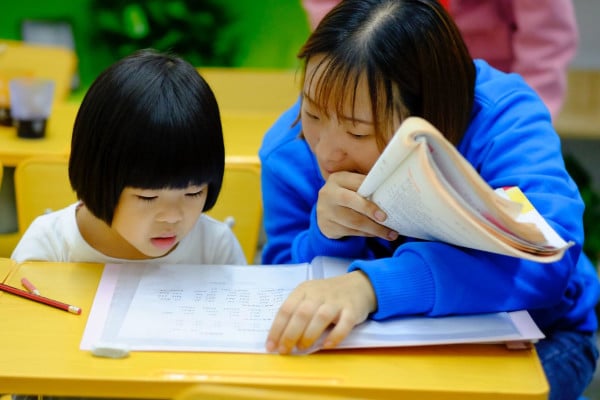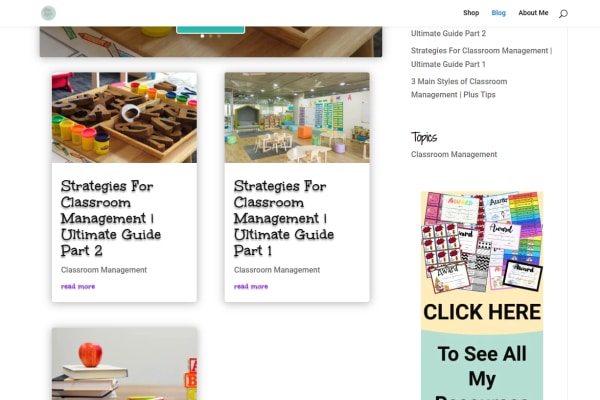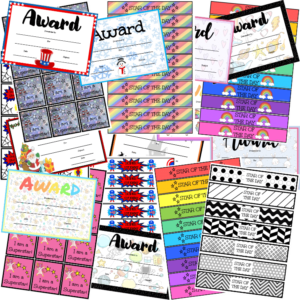Read Time 8 mins
What We'll Cover
- How I involve the children in the decision making process.
- Staying organized with my easy tips.
- What consistency looks like to me.
Welcome to part three of our series on strategies for classroom management. If you haven’t read part one or two, I encourage you to do so before continuing.
In part three, we’ll be discussing the importance of building one-to-one time with students, working within small groups, goal setting, having fun, and most importantly consistency.
Before we begin, if you have any questions, please feel reach out on my socials. I’ll happily answer and support you as best I can.
Small Groups- Are you using this classroom management technique?
Now I am almost positive the majority of teachers are using small group experiences throughout their day.
But what does it look like for you?
Small group activities are an excellent method to manage behavior while also ensuring that the children are communicating and collaborating.
It’s also true that this method develops good conduct while also allowing children to have a tailored learning experience. It’s not hard to see why this also provides students the chance to learn from one another.
Small groups allow children to interact and learn from one another.
This is a valuable experience that can help children develop social skills and understand different perspectives. Small groups can also be used to differentiate instruction and meet the needs of all learners.
Differentiation is important because it allows students to receive instruction that is tailored to their individual needs. This ensures that all students have an opportunity to learn and be successful in the classroom.
I love working with small groups because it allows me to get to know my students better. I can see how they interact with each other and identify any areas where they may need help.
Small group activities are a great way to:
- Manage behavior and ensure that all students are getting the most out of their learning experience.
- Provide opportunities for students to communicate and collaborate.
- Allows teachers to differentiate instruction.
- Plus, it’s just more fun for everyone.
I also see it as a great way to motivate students to stay on their best behavior.
Small groups also work for your continuous provisions throughout your play-based learning experiences.
Imagine this….
You’ve created a new role-play area, full of enriched learning opportunities. Everyone in class is extremely enthusiastic to get stuck in and engage.
Do you think it’s best to have 30 children run to the same area?
We all know the answer to this….. NO!
My strategy for classroom management here would be:
Set a number, of children allowed to engage in that area. Agree upon a number with your students, they are more likely to remember and stick to this if they influence the decision.
Print and laminate roles or numbers cards. Attach them to a lanyard and only students who are wearing the lanyard are able to engage in that area.
This also teaches patience and others will have to wait their turn.
This is key to ensuring other areas of your room are calm, positive, and full of enriched learning while you are with your group of students.
One-to-One: Haven’t got the time? Make time!
As a teacher, I believe that personal one-on-one time with each student is sacred. Group activities are great but one-on-one is where the magic happens for this.
It’s where you really see children develop but it can also be a time I can be more personalized with my students. For me, It shows that you value them as an individual, and it helps to build their confidence as well as that vital positive relationship you need to have with each student.
In a classroom of twenty or thirty students, it can be difficult to give each one the individual attention they need. However, one-to-one time with students is essential in order to build a rapport and ensure that they are engaging with the material.
This is especially true for students who are struggling, or who have personal or social issues that are affecting their learning. In these cases, one-to-one time allows you to build trust and address specific issues in a confidential setting.
It also provides an opportunity to give students targeted feedback on their progress.
In short, one-to-one time is an essential part of being an effective teacher. By taking the time to connect with each student individually, you can make a real difference in their lives.
Yes, I know it is hard but please know how vital this is for you as a teacher and for every single one of your students.
QUICK TIPS: One-to-One time.
- Group which students require it the most (some may need it a lot more than others, which is okay)
- Plan it – organize when and who prior to your week or even term.
- Let others know. Tell your team and your other students that when you are engaging in One-to-One time you are not to be interrupted (unless it’s an emergency) There is no point attempting to have this time with a student if you will be not 100% focused on that student.
- Wear something that shows you are in this special time. I usually wear a funny hat or a cape.
- Short of time? Make it 10 minutes and have a timer.
- Conversational Reading (Abecedarian Approach) is a key experience for this.
- Make it a habit.
Children’s Voice – A Key Strategy to Behavior management
We have touched on children having a voice in their classroom, here is where we go into a little detail.
Every classroom is different, and children’s voices are an important part of what makes each one unique. Classroom management and behavior management strategies that work for one group of children may not be effective for another.
This is where children’s input can be invaluable.
By involving children in the decision-making process, teachers can get a better sense of what will work for their class. In addition, children who feel that their voices are being heard are more likely to be engaged and invested in the classroom community.
When children feel like they have a say in the way their classroom is run, they are more likely to take pride in their environment and behave responsibly. As such, it is clear that children’s voices play an important role in the success of any classroom.
The importance of children’s voice in the classroom cannot be underestimated. Have a look at this from Edutopia and see why
“the amount of talk that students do is correlated with their achievement” – Simple Ways to Promote Student Voice in the Classroom – eduptopia.org
A children’s voice may be a little different from elementary/primary school to an Early Years setting. But it is still just as important.
In elementary/primary school, you will have a curriculum to stick to when teaching, which means you have to look for other ways to have your students’ input.
This could be class rules, the types of class helpers you require, class council, or even debates on a subject.
In the early years, this is something that can and should be done at every opportunity.
Some examples of this are:
- What do you want to learn about?
- Classroom rules
- Daily Experiences
- How to set up the classroom
- What do they want to see in their classroom
- Question of the day
As a result, children’s voices should be encouraged and valued in all classrooms.
Be Organized – How Organizing, will help your Classroom Management.
“Be organized” she says!
I hear you, I totally understand it sounds easier said than done. As a teacher, you need to be organized so that you can manage your time.
You can use different techniques to help keep your classroom organized and under control. It’s also a good way to show older students how to be productive in a classroom setting.
There are many different techniques you can use to keep your classroom organized.
I like to incorporate behavior management techniques as part of my organizing too.
Here’s how I go about it…
Create a daily schedule and post it so everyone can see it.
This will help the staff know what they should be doing at all times. What is the weekly plan? Which experiences are needed that day? Who is working with what group? Or as simple as laminating jobs that may need doing.
Either way, if your team knows what is happening then you can concentrate fully on your students.
Organization is a skill that will benefit students long after they leave your classroom.
It’s the simple things like teaching them how to stay on top of their belongings, keeping their work area tidy, and the like.
An organized environment is a clean and tidy environment. It’s a place where everything has its own specific place. When a student’s work area is organized, they know where everything is and can find it easily. This saves time and frustration. An organized student is a calm student who can focus on their studies and do their best work.
Hopefully, it’ll give them a head start in their future educational endeavors. Investing time in organization now will pay off in the form of well-organized and successful students in the future
Have Fun – Be Enthusiastic
As we come towards the end of the final part of my Strategies for Classroom Management. We need to remember a couple of things, one being
To Have Fun
We touched upon this in part two when we discussed morning warm-up dances. However, this is something we teachers can forget as we have so much on our minds.
Who has time to actually have fun with our class?
You do!
It is well known that students learn best when they are having fun. A fun and enthusiastic classroom is one where students feel comfortable taking risks, trying new things, and making mistakes. When students are having fun, they are more engaged and more likely to remember what they have learned.
Enthusiasm is also contagious, so when teachers are fun and enthusiastic, it helps to create a positive atmosphere in the classroom.
Classroom management is another important reason to keep things fun and upbeat in your classroom. When students feel like they are in a fun and supportive environment, they are less likely to misbehave.
On the other hand, when students are bored or feel unmotivated, they are more likely to act out. By making learning fun and engaging, you can help to prevent behavior problems in your classroom.
So, next time you are planning a lesson, make sure to include some fun and excitement! Your students will thank you for it.
Finally, Consistency- The most vital key point to any classroom management strategy.
Consistency is key when it comes to classroom management. If you are inconsistent with your behavior management strategies, your students will quickly catch on and start testing the boundaries.
On the other hand, a consistent approach will help to create a calm and orderly environment where students feel safe and secure.
It is important to remember that consistency doesn’t mean using the same techniques all the time. Instead, it means being consistent in your application of different techniques. For example, you might use different approaches for addressing minor infractions and major disruptions.
However, the key is to be consistent in how you handle each type of behavior. By establishing clear expectations and applying them consistently, you can create a positive learning environment for all your students.
QUICK TIP: Ensure all of your team are on the same page. This supports a consistent approach to your classroom management strategies.
Strategies for classroom management we’ve discussed in the Three posts.
- In order to foster a positive learning environment and master other techniques for classroom management styles, teachers MUST have positive relationships with their students.
- Establishing trust is key and mutual respect allows for open communication and facilitates the exchange of ideas. When children feel comfortable in their surroundings, they are more likely to behave appropriately.
- Several techniques for classroom management can be used to manage student behavior properly without resorting to yelling or negative talk.
- Consistency is key throughout.
I hope you found these strategies for classroom management helpful.
If you are looking for more ways to improve your classroom management or would like help implementing any of these strategies, please don’t hesitate to get in touch with me. I also have at tools up my sleeve i have created. Check them out here.
I aim to help create a positive and successful learning environment for as many students as I can.
I’d LOVE to help.
Miss Kate x






